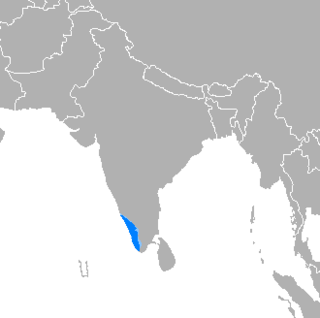
The Dravidian languages are a family of languages spoken by 250 million people, mainly in South India, north-east Sri Lanka, and south-west Pakistan, with pockets elsewhere in South Asia.

Tamil is a Dravidian language natively spoken by the Tamil people of South Asia. It is one of the two longest-surviving classical languages in India, along with Sanskrit, attested since c. 300 BCE.

Malayalam is a Dravidian language spoken in the Indian state of Kerala and the union territories of Lakshadweep and Puducherry by the Malayali people. It is one of 22 scheduled languages of India. Malayalam was designated a "Classical Language of India" in 2013. Malayalam has official language status in Kerala, Lakshadweep and Puducherry (Mahé), and is also the primary spoken language of Lakshadweep. Malayalam is spoken by 35 million people in India. Malayalam is also spoken by linguistic minorities in the neighbouring states; with a significant number of speakers in the Kodagu and Dakshina Kannada districts of Karnataka, and Kanyakumari, Coimbatore and Nilgiris district of Tamil Nadu. It is also spoken by the Malayali Diaspora worldwide, especially in the Persian Gulf countries, due to the large populations of Malayali expatriates there. They are a significant population in each city in India including Mumbai, Bengaluru, Chennai, Delhi, Hyderabad etc.

The Tamil script is an abugida script that is used by Tamils and Tamil speakers in India, Sri Lanka, Malaysia, Singapore, Indonesia and elsewhere to write the Tamil language. It is one of the official scripts of the Indian Republic. Certain minority languages such as Saurashtra, Badaga, Irula and Paniya are also written in the Tamil script.

The Grantha script was a classical South Indian Brahmic script, found particularly in Tamil Nadu and Kerala. Originating from the Pallava script, the Grantha script is related to Tamil and Vatteluttu scripts. The modern Malayalam script of Kerala is a direct descendant of the Grantha script. The Southeast Asian and Indonesian scripts such as Thai and Javanese respectively, as well as South Asian Tigalari and Sinhala scripts, are derived or closely related to Grantha through the early Pallava script. The Pallava script or Pallava Grantha emerged in the 4th century CE and was used until the 7th century CE, in India. This early Grantha script was used to write Sanskrit texts, inscriptions on copper plates and stones of Hindu temples and monasteries. It was also used for classical Manipravalam – a language that is a blend of Sanskrit and Tamil. From it evolved Middle Grantha by the 7th century, and Transitional Grantha by about the 8th century, which remained in use until about the 14th century. Modern Grantha has been in use since the 14th century and into the modern era, to write classical texts in Sanskrit and Dravidian languages. It is also used to chant hymns and in traditional Vedic schools.
Tolkāppiyam, also romanised as Tholkaappiyam, is the most ancient extant Tamil grammar text and the oldest extant long work of Tamil literature. It is the earliest Tamil text mentioning Gods, perhaps linked to Hindu deities.
Sankethi is a South Dravidian language that is closely related to Kannada and Tamil. It is sometimes considered a dialect of Kannada or Tamil, but there are considerable differences that make it unintelligible to speakers of both languages. It has strong lexical influences from Kannada, as well as borrowings from Sanskrit. It is most commonly spoken in Karnataka, India by the Sankethi people, who migrated from Sengottai in Tamil Nadu.

Manipravalam is a macaronic language found in some manuscripts of South India. It is a hybrid language, typically written in the Grantha script, which combines Sanskrit lexicon and Tamil morpho-syntax. According to language scholars Giovanni Ciotti and Marco Franceschini, the blending of Tamil and Sanskrit is evidenced in manuscripts and their colophons over a long period of time, and this ultimately may have contributed to the emergence of Manipravalam. However, the 14th century Sanskrit work Lilatilakam states that Manipravalam is a combination of Tamil and Sanskrit. Generally, it is agreed that it was a combination of Middle Tamil and Sanskrit.

Since the Iron Age in India, the native languages of the Indian subcontinent are divided into various language families, of which the Indo-Aryan and the Dravidian are the most widely spoken. There are also many languages belonging to unrelated language families such as Munda and Tibeto-Burman, spoken by smaller groups.
The grammar of the Sanskrit language has a complex verbal system, rich nominal declension, and extensive use of compound nouns. It was studied and codified by Sanskrit grammarians from the later Vedic period, culminating in the Pāṇinian grammar of the 4th century BCE.
Vatteluttu or Vattezhuthu was an alphasyllabic writing system of south India and Sri Lanka used for writing the Tamil and Malayalam languages.
Tamil phonology is characterised by the presence of "true-subapical" retroflex consonants and multiple rhotic consonants. Its script does not distinguish between voiced and unvoiced consonants; phonetically, voice is assigned depending on a consonant's position in a word, voiced intervocalically and after nasals except when geminated. Tamil phonology permits few consonant clusters, which can never be word initial.
In the field of linguistics, syntactic change is change in the syntactic structure of a natural language.
Malayalam is one of the Dravidian languages and has an agglutinative grammar. The word order is generally subject–object–verb, although other orders are often employed for reasons such as emphasis. Nouns are inflected for case and number, whilst verbs are conjugated for tense, mood, and causativity. Malayalam adjectives, adverbs, postpositions, and conjunctions do not undergo any inflection; they are invariant.

Old Tamil is the period of the Tamil language spanning from 300 BCE to 700 CE. Prior to Old Tamil, the period of Tamil linguistic development is termed as Proto-Tamil. After the Old Tamil period, Tamil becomes Middle Tamil. The earliest records in Old Tamil are inscriptions from between the 3rd and 1st century BCE in caves and on pottery. These inscriptions are written in a variant of the Brahmi script called Tamil Brahmi. The earliest long text in Old Tamil is the Tolkāppiyam, an early work on Tamil grammar and poetics, whose oldest layers could be as old as the mid 2nd century BCE. Old Tamil preserved many features of Proto-Dravidian, the earliest reconstructed form of the Dravidian including inventory of consonants, the syllable structure, and various grammatical features.
Beary or Byari is a geographically isolated dialect of Malayalam spoken by the Bearys who are part of the Muslim community in Tulu Nadu region of Southern Karnataka and Northern Kerala. The community is often recognized as Bearys or Beary Muslims. Beary is influenced by Tulu phonology and grammar. Due to the trading role of the community, the language acquired loan words from other languages of Tulu, Kannada, and from Perso-Arabic sources.
Malaysian Tamil, also known as Malaya Tamil, is a local variant of the Tamil language spoken in Malaysia. It is one of the languages of education in Malaysia, along with English, Malay and Mandarin. There are many differences in vocabulary between Malaysian Tamil and Indian Tamil.
Old Telugu is the earliest attested stage of the Telugu language.

Old Malayalam, the inscriptional language found in Kerala from c. 9th to c. 13th century CE, is the earliest attested form of Malayalam. The language was employed in several official records and transactions. Old Malayalam was mostly written in Vatteluttu script. Most of the inscriptions were found from the northern districts of Kerala, those lie adjacent to Tulu Nadu. The origin of Malayalam calendar dates back to year 825 CE.
Extended-Tamil script or Tamil-Grantha refers to a script used to write the Tamil language before the 20th century Tamil purist movement. Tamil-Grantha is a mixed-script: a combination of the conservative-Tamil script that independently evolved from pre-Pallava script, combined with consonants imported from a later-stage evolved Grantha script to write non-Tamil consonants. Some scholars posit that the origin of Tamil-Grantha is unclear: the script could also be a direct descendant of the Pallava-Grantha script which extensively developed during the Middle Tamil period to write Middle-Tamil.








